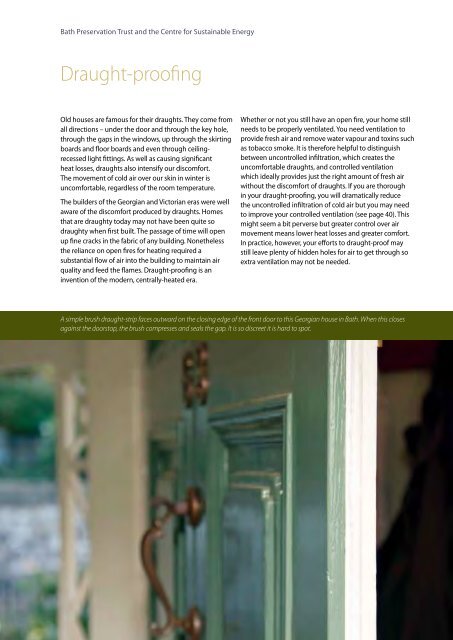Warmer Bath
Create successful ePaper yourself
Turn your PDF publications into a flip-book with our unique Google optimized e-Paper software.
<strong>Bath</strong> Preservation Trust and the Centre for Sustainable Energy<br />
Draught-proofing<br />
Old houses are famous for their draughts. They come from<br />
all directions – under the door and through the key hole,<br />
through the gaps in the windows, up through the skirting<br />
boards and floor boards and even through ceilingrecessed<br />
light fittings. As well as causing significant<br />
heat losses, draughts also intensify our discomfort.<br />
The movement of cold air over our skin in winter is<br />
uncomfortable, regardless of the room temperature.<br />
The builders of the Georgian and Victorian eras were well<br />
aware of the discomfort produced by draughts. Homes<br />
that are draughty today may not have been quite so<br />
draughty when first built. The passage of time will open<br />
up fine cracks in the fabric of any building. Nonetheless<br />
the reliance on open fires for heating required a<br />
substantial flow of air into the building to maintain air<br />
quality and feed the flames. Draught-proofing is an<br />
invention of the modern, centrally-heated era.<br />
Whether or not you still have an open fire, your home still<br />
needs to be properly ventilated. You need ventilation to<br />
provide fresh air and remove water vapour and toxins such<br />
as tobacco smoke. It is therefore helpful to distinguish<br />
between uncontrolled infiltration, which creates the<br />
uncomfortable draughts, and controlled ventilation<br />
which ideally provides just the right amount of fresh air<br />
without the discomfort of draughts. If you are thorough<br />
in your draught-proofing, you will dramatically reduce<br />
the uncontrolled infiltration of cold air but you may need<br />
to improve your controlled ventilation (see page 40). This<br />
might seem a bit perverse but greater control over air<br />
movement means lower heat losses and greater comfort.<br />
In practice, however, your efforts to draught-proof may<br />
still leave plenty of hidden holes for air to get through so<br />
extra ventilation may not be needed.<br />
A simple brush draught-strip faces outward on the closing edge of the front door to this Georgian house in <strong>Bath</strong>. When this closes<br />
against the doorstop, the brush compresses and seals the gap. It is so discreet it is hard to spot.<br />
36


